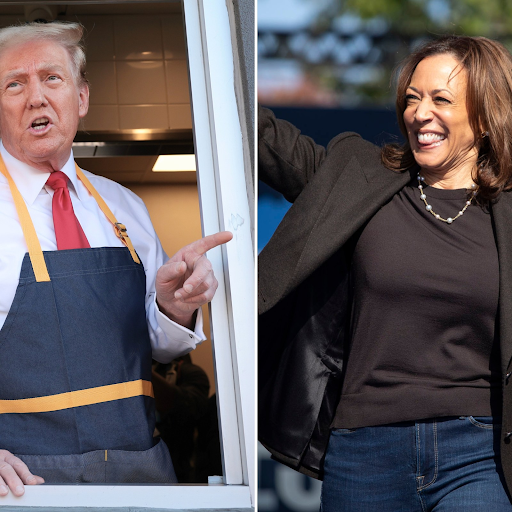Last week, Vice President Kamala Harris spent a warm October weekend in Georgia giving speeches at several churches. On the other hand, Former President Trump visited and made fries at a small PA McDonalds, handing out food to his supporters through a small drive-through window [1].
The contrast between the two candidates couldn’t be clearer––but as the election draws closer, they’ve both been trying their hand at various campaign strategies to try and draw voters to their side of the game. These last couple weeks are going to be vital: with Harris and Trump both polling at 48%, no one knows what will tip the election in either direction [2].
But what exactly are their campaign strategies?
For one, unlike President Biden, Harris has been focusing on more GOP-leaning areas in recent weeks, targeting older, mostly non-college-educated, white workers. They make up a huge voting bloc, yet are traditionally neglected by Democrats [3,4]. Visiting several smaller, traditionally conservative counties, Harris and running mate Tim Walz have been focusing on issues such as price gouging, the cost of prescription drugs, and abortion rights [3]. Throughout their campaign, they have attempted to increase their relatability with working-class Americans, both Harris and Walz referencing their middle-class upbringings and frequently using anti-elitist rhetoric [4]. Harris has also launched many ads targeting middle-class voters across betting sites and during football games, hoping to reach out to those who don’t stay updated with politics [5].
However, Harris has also needed to garner support from another key voting block: Black male workers. Democrats have been losing standing among Black male workers for years, taking them for granted rather than prioritizing their needs. Harris has tried to turn this around, launching the “Opportunity Agenda for Black Men” plan, which would help forgive loans for Black entrepreneurs. Additionally, she is trying to bring health initiatives that focus on diseases that disproportionately affect Black men and framing herself as a defendant of American workers [6].
Harris has also targeted the fact that Trump was born with a so-called “silver spoon” in his hand, claiming that he is too elitist to understand the working class [6]. Yet rather than focusing on attacks and painting him as a threat, she has portrayed Trump as a joke and utilized humor to make voters think that Trump is “out of his mind” [10].
Former President Trump’s campaign has also taken a unique turn. On one hand, he has followed a very traditional path of consistently campaigning in battleground states and devoting 90% of his advertising budget to those states [7]. On the other hand, he has begun focusing on “low propensity voters”, who are typically disconnected from politics and often do not vote. To get these voters, Trump and his allying SuperPACs have hired numerous canvassing outfits and have been going door to door, talking to citizens [8]. He has also started appearing on podcasts, particularly those listened to by young men, such as those of Joe Rogan and Logan Paul. These podcasts help him to create headlines and reach out to voters who may not have participated in the election otherwise, but instead look up to the podcasters [9]. Contrary to Harris, Trump has been focusing on crowd sizes and headlines––showier aspects that enable him to garner attention [7].
Further, Trump has targeted the fear of workers. He has channeled the hurt and fury of Americans who feel that they’ve been robbed of the American Dream into a sense of relatability that makes voters view him as an ally [6]. Similarly, he has continually attacked Harris’s progressivism as well as her past, relying on division and chaos to get ahead [7].
While both candidates have differed in their methods of getting ahead and have continually diverged from the strategies of their predecessors, one thing is clear: every step they take could be game-changing (or destroying). Whatever happens will be written in history books for centuries to come, and will have long-lasting implications on American democracy and society. Who knows what will be the factor that decides the conclusion of this movie-like saga?
Sources:
[2] https://www.nytimes.com/2024/10/25/us/politics/poll-harris-trump-times-siena.html
[3] https://www.politico.com/news/2024/09/14/kamala-harris-swing-voter-campaign-stop-strategy-00179195
[6] https://www.nytimes.com/2024/10/14/us/politics/harris-policies-black-men.html#
[7] https://www.politico.com/news/2024/10/23/trump-sideshows-swing-state-campaign-strategy-00184923
[10] https://www.nytimes.com/2024/09/03/opinion/harris-trump-election.html#

